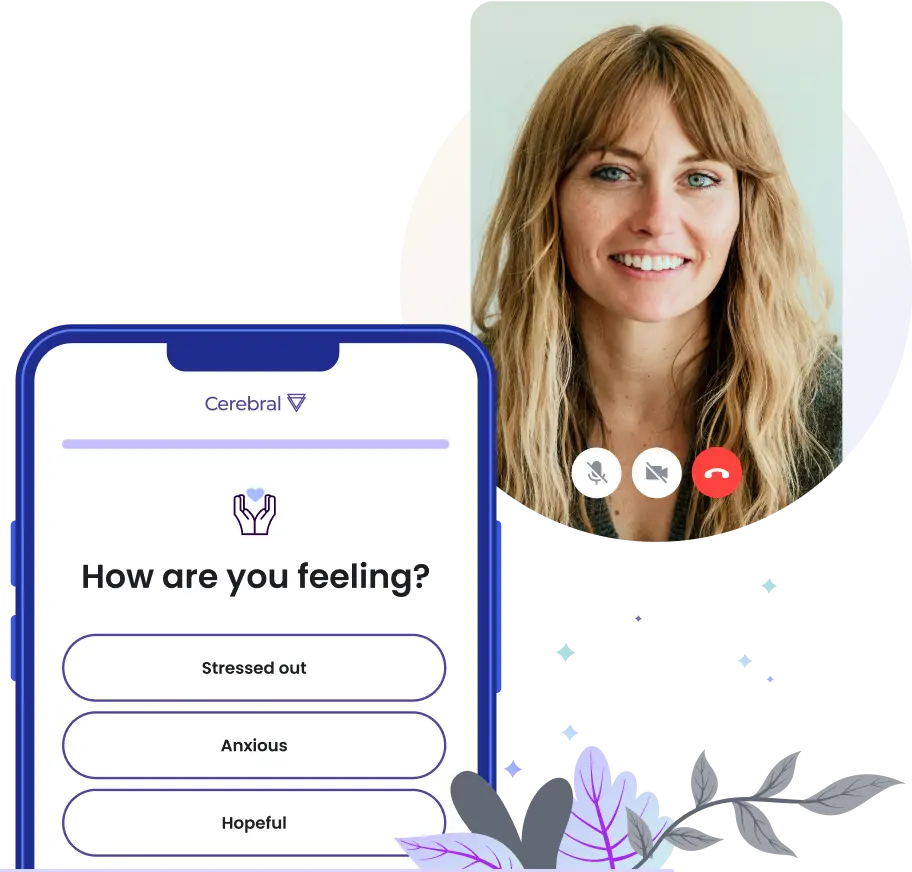The Difference Between Anxiety and Fear

In our daily lives, feelings of anxiety and fear can surface, intermingling in ways that make them tough to distinguish. However, understanding the distinction between the two helps in managing them effectively, leading to improved emotional resilience.
While both are natural and common responses to threats, they’re influenced by different triggers and operate on separate timelines. Confusion between these emotions arises because they share physical symptoms and can affect us simultaneously.
In this guide, we’ll dissect the differences between the two.
What is anxiety?
Anxiety is a natural human response to stress, a feeling of unease or apprehension about what's to come. It’s part of the body’s flight-or-fight mechanism that helps us prepare for an immediate threat by getting us to react to the situation.
Anxious feelings become a concern when they occur frequently, leaving a person in a persistent state of anxiety. We all can have feelings of anxiety, but people can also have anxiety disorders. It’s an important distinction to recognize.
Symptoms of anxiety
The symptoms of anxiety can vary from person to person, but common physical and emotional indicators include:
- Rapid heartbeat
- Sweating or trembling
- Difficulty concentrating
- Restlessness or irritability
- Muscle tension and aches
- Nausea or stomach upset
These physical signs are often accompanied by persistent worry and fear about everyday situations, making it more difficult for a person to function in their daily life.
Types of anxiety disorders
Anxiety disorders are classified into specific types, including generalized anxiety disorder (GAD), panic disorder, social anxiety disorder, and phobias. Each type has its own set of symptoms and triggers that can vary from person to person.
Explore more: Anxiety Disorders — Here’s What You Should Know
What is fear?
Fear is also a natural emotion that is triggered by a real and present danger. Functioning as the mind and body's response to an immediate threat, fear motivates us to act in the interest of our survival and safety.
It can be triggered by a scary situation, whether it's real or perceived.
Symptoms of fear
Similar to anxiety, fear also has physical and emotional symptoms that accompany it. These may include:
- Shaking or trembling
- Sweating
- Feeling dizzy or lightheaded
- Dry mouth or difficulty swallowing
- Numbness in the body
Similar to anxiety, fear is a feeling we all can have, but when the fear becomes irrational, persistent, and significantly distressing, it can evolve into a phobia.
Phobias are categorized as a type of anxiety disorder characterized by an intense, excessive, and persistent fear of a specific object, situation, or activity that is often out of proportion to the actual danger presented. Unlike the occasional fear that can be managed or rationalized, phobias can lead individuals to go to great lengths to avoid their source of fear, significantly impacting their daily lives and well-being.
The treatment for phobias often includes therapy, particularly cognitive-behavioral therapy, which helps patients gradually build exposure to the feared object or situation in a controlled and safe manner.
Understanding ‘fight or flight’
The 'fight or flight' response is the body's reaction to a sudden danger or threat.
During this reaction, certain hormones like adrenaline and cortisol are released, and physical changes, such as increased heart rate and blood pressure, occur to prepare a person to either fight the oncoming threat or flee to safety.
This response is a survival mechanism that has evolved over time to protect us from danger and harm.

The difference between anxiety and fear
Fear and anxiety share a common root in the fight-or-flight response, but there are some key differences between the two emotions:
- Trigger: Fear is triggered by a known or present threat, whereas anxiety can be triggered by both real and imagined future events.
- Physical symptoms: Both emotions can cause physical symptoms like rapid heartbeat and muscle tension, but anxiety can also lead to digestive issues, sleep problems, and fatigue when experienced long-term.
Both emotions involve a range of physical and psychological symptoms that are intended to protect us. However, they can be burdensome if they persist when there is no immediate danger threatening our safety, just as they typically do with anxiety.
One major difference between the two is the duration of the feeling. While it can last longer in long-term life-threatening situations, fear is typically short-lived, while anxiety can linger for prolonged periods.
Physical symptoms
- Fear: Immediate and intense; driven by a specific circumstance.
- Anxiety: Persistent and long-lasting; can be triggered by vague or unknown concerns.
Psychological symptoms
- Fear: Often leads to the need for immediate, direct action.
- Anxiety: Worry, and a feeling of imminent danger; vague but persistent nature.
Being aware of these distinctions will help you manage anxiety or fear effectively, ensuring that responses to both known and unknown threats are appropriate and healthy.
Go deeper: Understand how to describe other feelings with our free Emotion Wheel resource.

Coping with anxiety and fear
Understanding the differences is the first step, but knowing how to cope is where strategies become vital. Here are some of the techniques that can help you manage anxiety as well as fear:
- Understand your triggers: Identifying what triggers your anxieties or fears is a crucial step in learning how to manage and overcome them. Keep a trigger log, write in a journal, or seek professional help to understand the patterns and root causes.
- Practice mindfulness: Living in the present moment can be incredibly grounding. Techniques like meditation and controlled breathing exercises can help keep anxiety at bay by focusing on the here and now.
- Social connection: Opening up to friends and family about your feelings can alleviate the sense of isolation that often accompanies anxiety and fear.
- Relaxation techniques: Engage in activities that relax you, such as taking a bath, reading a book, listening to calming music, or trying progressive muscle relaxation. This can help balance your overstimulated system.
- Exercise: Physical activity is a great way to reduce anxiety and fear. It distracts the mind and releases endorphins that can uplift your mood and energy levels.
By addressing anxiety or fear with informed coping strategies, you can work towards reclaiming control and balance in your life.
When to seek help
Addressing these emotions early on can lead to better outcomes and long-term management, but it’s important to recognize when self-help isn’t enough.
If these emotions are interfering with your daily life, it could be a sign to reach out to a mental health professional for further evaluation and help managing anxiety or your fears.
Treatment options for anxiety
Understanding the distinctions between anxiety and fear helps dispel confusion, empowering you with emotional coping strategies and tailored care plans.
Several treatment options exist for anxiety disorders, ranging from therapy to medication. Some modalities can also help address phobias or extreme fears.
Cognitive behavioral therapy (CBT)
CBT is one of the most effective treatments for anxiety disorders. It focuses on changing patterns of thinking or behavior that lead to anxious feelings, helping individuals understand and manage their symptoms better.
Dialectical behavior therapy (DBT)
This modality blends cognitive-behavioral techniques with mindfulness practices, focusing on improving emotional regulation by recognizing the triggers that lead to reactive states that can be caused by anxiety disorders. DBT could empower you to interrupt the cycle of anxiety and manage these intense emotional experiences to prevent any escalation of anxiety symptoms.
Free resource: How to Soothe Anxiety with DBT Skills
Medication
In some cases, medication may be prescribed to help manage the symptoms of anxiety disorders. This could include anti-anxiety medication, beta blockers, or selective serotonin reuptake inhibitors (SSRIs) that can help regulate brain chemicals. It’s crucial to discuss the benefits and potential risks with a healthcare provider before pursuing medication.
Exposure therapy
This form of therapy involves exposing the patient to their fears or anxiety triggers in a controlled environment, helping them become desensitized and learn how to manage their reactions. It is often used to treat specific phobias.
Acceptance and commitment therapy (ACT)
ACT encourages individuals to accept what is beyond their control while committing to making a conscious behavior change. It's particularly effective for people trying to overcome intense fears and phobias.
Remember: Treatment options are not one-size-fits-all, and what works for one person may not work for another.
It's essential to work with a mental health professional to find an effective treatment plan for you based on your situation and symptoms and, if applicable, a diagnosis.

How do I know if I have anxiety?
If you’re asking yourself the above and wondering if you could possibly have an anxiety disorder, Cerebral is here to help you find answers.
In addition to many of our other free therapy and mental health resources, we also offer a free anxiety screener. This tool can help you make an informed decision about whether to seek help from a licensed mental health professional.
A self-test can be a useful initial step if you’re looking to get a sense of the level of your anxiety symptoms. You can take a 3-minute self-test to find out where your thinking, behaviors, experiences, and sensations fall on a scale of normal to severe.
Images by freepik, freepik, lookstudio, and freepik on Freepik.
The information in this blog is provided as a general educational resource only, and is not to be used or relied on for any diagnostic or treatment purpose. This information should not be used as a substitute for professional diagnosis and treatment and does not create any patient-physician relationship between you and Cerebral. Please consult your health care provider before making any health care decisions or to get guidance about a specific medical condition.

Relationship Anxiety: Understand the Signs and Ways to Cope

Anxiety and Memory Loss

Experts Recommend Anxiety Screening for Those 19-65

Call 911 if you’re having a
mental health emergency
Text Home to 741-741 if you're in emotional
distress and need immediate support
Call or text 988 Suicide &
Crisis Lifeline. Chat service
is available at 988lifeline.org.